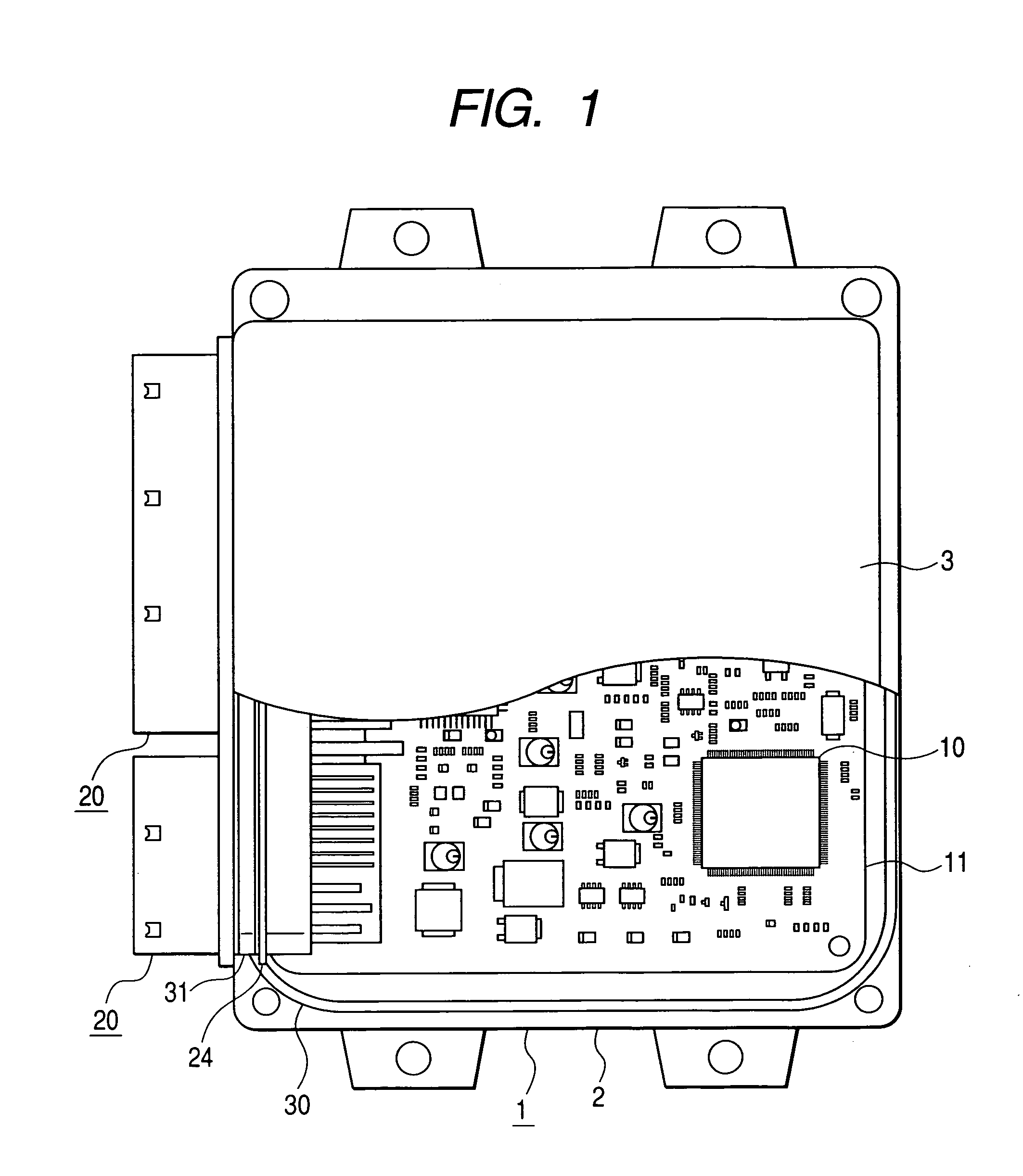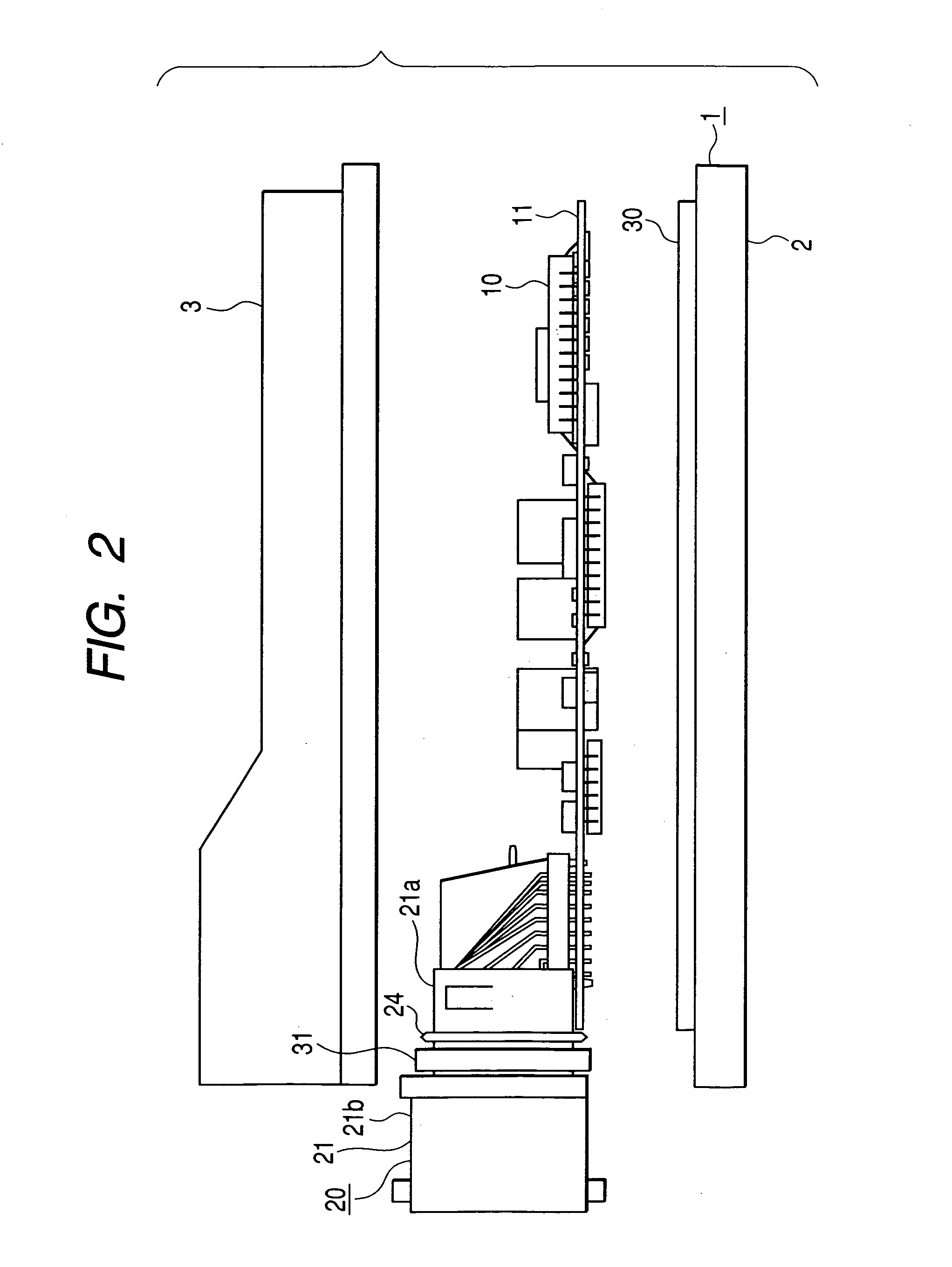Water-resistant casing structure for electronic control device
a casing structure and electronic control technology, applied in the direction of electrical apparatus casings/cabinets/drawers, coupling contact members, securing/insulating couplings, etc., can solve the problems of reducing the service life of the electronic control device. b>101/b>, to achieve the effect of minimizing stresses and reliable operation
- Summary
- Abstract
- Description
- Claims
- Application Information
AI Technical Summary
Benefits of technology
Problems solved by technology
Method used
Image
Examples
1st embodiment
[0043]As shown in FIGS. 1 and 2, a water-resistant casing structure according to a first embodiment of the present invention has a casing 1 housing the electronic control device therein. The casing 1 comprises a lower case 2 serving as a base plate and an upper case 3 serving as a cover. The lower case 2 is in the form of an aluminum die-casting, and the upper case 3 is molded of synthetic resin. The lower case 2 comprises a flat square plate. The upper case 3 comprises a downwardly open square box having a lower opening, and is mounted on the lower case 2 which closes the lower opening of the upper case 3. The lower case 2 and the upper case 3 are fastened to each other by screws, for example, with an annular water-resistant seal 30 interposed therebetween. The annular water-resistant seal 30 hermetically seals the space defined between the lower case 2 and the upper case 3. The box-shaped casing 1 is substantially square in shape as viewed in plan, and has a height much smaller th...
2nd embodiment
[0060]A water-resistant casing structure according to a second embodiment of the present invention will be described below with reference to FIGS. 6, 7, and 8. Only parts of the water-resistant casing structure according to the second embodiment which are different from the water-resistant casing structure according to the first embodiment will be described in detail below.
[0061]According to the second embodiment, as shown in FIGS. 6, 7, and 8, a tooth 60 as a stop is disposed on the casing 1, i.e., the upper case 3 thereof, at a position closely confronting the connector 20 near the region sealed by the water-resistant seat 31.
[0062]Specifically, the inner block member 21a of the connector 21 extends through the joint hole 4 into the casing 1, and has an upper surface closely confronting the upper case 3 of the casing 1. The tooth 60 is disposed at a central position in the horizontal direction in FIG. 7. The tooth 60 is integrally formed with the upper case 3 in a region which is ...
3rd embodiment
[0064]A water-resistant casing structure according to a third embodiment of the present invention will be described below with reference to FIGS. 9, 10, and 11. Only parts of the water-resistant casing structure according to the third embodiment which are different from the water-resistant casing structure according to the second embodiment will be described in detail below.
[0065]According to the third embodiment, as shown in FIGS. 9, 10, and 11, a tooth 70 as a stop is disposed on the connector 20, i.e., the inner block member 21a thereof, at a position closely confronting the casing 1 near the region sealed by the water-resistant seat 31.
[0066]Specifically, the tooth 70 is integrally formed with an upper surface of the inner block member 21a in a region which is positioned slightly inwardly of the water-resistant seal 31, i.e., in a region which is not contacted by the water-resistant seal 31. The tooth 70 is disposed at a central position in the horizontal direction in FIG. 10. T...
PUM
 Login to View More
Login to View More Abstract
Description
Claims
Application Information
 Login to View More
Login to View More - R&D
- Intellectual Property
- Life Sciences
- Materials
- Tech Scout
- Unparalleled Data Quality
- Higher Quality Content
- 60% Fewer Hallucinations
Browse by: Latest US Patents, China's latest patents, Technical Efficacy Thesaurus, Application Domain, Technology Topic, Popular Technical Reports.
© 2025 PatSnap. All rights reserved.Legal|Privacy policy|Modern Slavery Act Transparency Statement|Sitemap|About US| Contact US: help@patsnap.com



